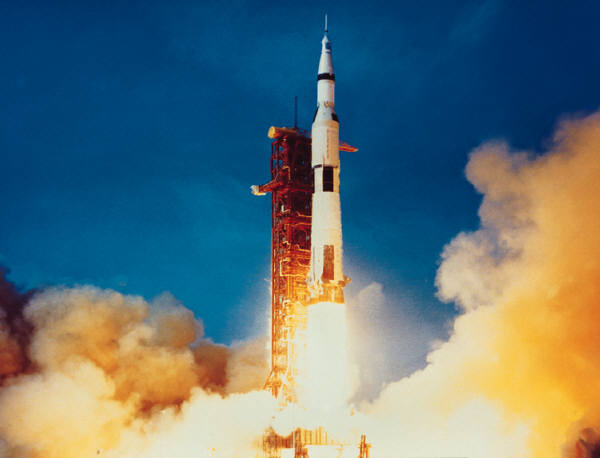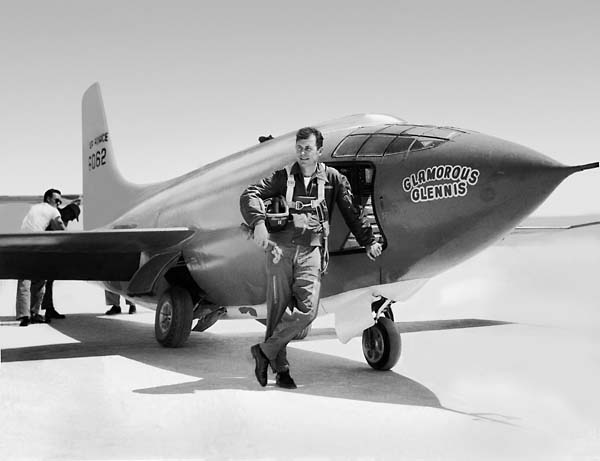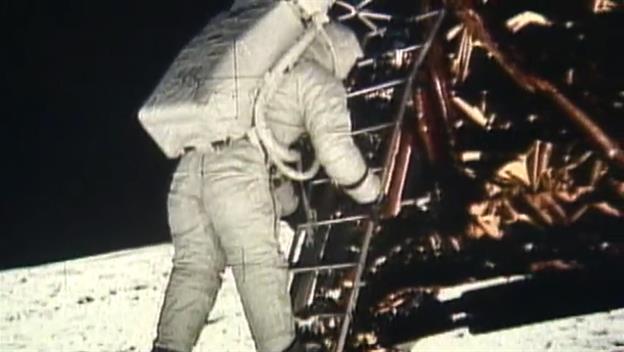This Day In History
Apollo 13 launched to moon

On April 11, 1970, Apollo 13, the third lunar landing mission, is successfully launched from Cape Canaveral, Florida, carrying astronauts James A. Lovell, John L. Swigert, and Fred W. Haise. The spacecraft’s destination was the Fra Mauro highlands of the moon, where the astronauts were to explore the Imbrium Basin and conduct geological experiments. After an oxygen tank exploded on the evening of April 13, however, the new mission objective became to get the Apollo 13 crew home alive.
At 9:00 p.m. EST on April 13, Apollo 13 was just over 200,000 miles from Earth. The crew had just completed a television broadcast and was inspecting Aquarius, the Landing Module (LM). The next day, Apollo 13 was to enter the moon’s orbit, and soon after, Lovell and Haise would become the fifth and sixth men to walk on the moon. At 9:08 p.m., these plans were shattered when an explosion rocked the spacecraft. Oxygen tank No. 2 had blown up, disabling the normal supply of oxygen, electricity, light, and water. Lovell reported to mission control: “Houston, we’ve had a problem here,” and the crew scrambled to find out what had happened. Several minutes later, Lovell looked out of the left-hand window and saw that the spacecraft was venting a gas, which turned out to be the Command Module’s (CM) oxygen. The landing mission was aborted.
As the CM lost pressure, its fuel cells also died, and one hour after the explosion mission control instructed the crew to move to the LM, which had sufficient oxygen, and use it as a lifeboat. The CM was shut down but would have to be brought back on-line for Earth reentry. The LM was designed to ferry astronauts from the orbiting CM to the moon’s surface and back again; its power supply was meant to support two people for 45 hours. If the crew of Apollo 13 were to make it back to Earth alive, the LM would have to support three men for at least 90 hours and successfully navigate more than 200,000 miles of space. The crew and mission control faced a formidable task.
To complete its long journey, the LM needed energy and cooling water. Both were to be conserved at the cost of the crew, who went on one-fifth water rations and would later endure cabin temperatures that hovered a few degrees above freezing. Removal of carbon dioxide was also a problem, because the square lithium hydroxide canisters from the CM were not compatible with the round openings in the LM environmental system. Mission control built an impromptu adapter out of materials known to be onboard, and the crew successfully copied their model.
Navigation was also a major problem. The LM lacked a sophisticated navigational system, and the astronauts and mission control had to work out by hand the changes in propulsion and direction needed to take the spacecraft home. On April 14, Apollo 13 swung around the moon. Swigert and Haise took pictures, and Lovell talked with mission control about the most difficult maneuver, a five-minute engine burn that would give the LM enough speed to return home before its energy ran out. Two hours after rounding the far side of the moon, the crew, using the sun as an alignment point, fired the LM’s small descent engine. The procedure was a success; Apollo 13 was on its way home.
For the next three days, Lovell, Haise, and Swigert huddled in the freezing lunar module. Haise developed a case of the flu. Mission control spent this time frantically trying to develop a procedure that would allow the astronauts to restart the CM for reentry. On April 17, a last-minute navigational correction was made, this time using Earth as an alignment guide. Then the repressurized CM was successfully powered up after its long, cold sleep. The heavily damaged service module was shed, and one hour before re-entry the LM was disengaged from the CM. Just before 1 p.m., the spacecraft reentered Earth’s atmosphere. Mission control feared that the CM’s heat shields were damaged in the accident, but after four minutes of radio silence Apollo 13‘s parachutes were spotted, and the astronauts splashed down safely into the Pacific Ocean.
– History.com Staff
This Day In History
Truman announces development of H-bomb

U.S. President Harry S. Truman publicly announces his decision to support the development of the hydrogen bomb, a weapon theorized to be hundreds of times more powerful than the atomic bombs dropped on Japan during World War II.
Five months earlier, the United States had lost its nuclear supremacy when the Soviet Union successfully detonated an atomic bomb at their test site in Kazakhstan. Then, several weeks after that, British and U.S. intelligence came to the staggering conclusion that German-born Klaus Fuchs, a top-ranking scientist in the U.S. nuclear program, was a spy for the Soviet Union. These two events, and the fact that the Soviets now knew everything that the Americans did about how to build a hydrogen bomb, led Truman to approve massive funding for the superpower race to complete the world’s first “superbomb,” as he described it in his public announcement on January 31.
On November 1, 1952, the United States successfully detonated “Mike,” the world’s first hydrogen bomb, on the Eniwetok Atoll in the Pacific Marshall Islands. The 10.4-megaton thermonuclear device, built upon the Teller-Ulam principles of staged radiation implosion, instantly vaporized an entire island and left behind a crater more than a mile wide. The incredible explosive force of Mike was also apparent from the sheer magnitude of its mushroom cloud–within 90 seconds the mushroom cloud climbed to 57,000 feet and entered the stratosphere. One minute later, it reached 108,000 feet, eventually stabilizing at a ceiling of 120,000 feet. Half an hour after the test, the mushroom stretched 60 miles across, with the base of the head joining the stem at 45,000 feet.
Three years later, on November 22, 1955, the Soviet Union detonated its first hydrogen bomb on the same principle of radiation implosion. Both superpowers were now in possession of the “hell bomb,” as it was known by many Americans, and the world lived under the threat of thermonuclear war for the first time in history.
Source: https://www.history.com/this-day-in-history/truman-announces-development-of-h-bomb
This Day In History
Gandhi assassinated

Mohandas Karamchand Gandhi, the political and spiritual leader of the Indian independence movement, is assassinated in New Delhi by a Hindu extremist.
Born the son of an Indian official in 1869, Gandhi’s Vaishnava mother was deeply religious and early on exposed her son to Jainism, a morally rigorous Indian religion that advocated nonviolence. Gandhi was an unremarkable student but in 1888 was given an opportunity to study law in England. In 1891, he returned to India, but failing to find regular legal work he accepted in 1893 a one-year contract in South Africa.
Settling in Natal, he was subjected to racism and South African laws that restricted the rights of Indian laborers. Gandhi later recalled one such incident, in which he was removed from a first-class railway compartment and thrown off a train, as his moment of truth. From thereon, he decided to fight injustice and defend his rights as an Indian and a man. When his contract expired, he spontaneously decided to remain in South Africa and launched a campaign against legislation that would deprive Indians of the right to vote. He formed the Natal Indian Congress and drew international attention to the plight of Indians in South Africa. In 1906, the Transvaal government sought to further restrict the rights of Indians, and Gandhi organized his first campaign of satyagraha, or mass civil disobedience. After seven years of protest, he negotiated a compromise agreement with the South African government.
In 1914, Gandhi returned to India and lived a life of abstinence and spirituality on the periphery of Indian politics. He supported Britain in the First World War but in 1919 launched a new satyagraha in protest of Britain’s mandatory military draft of Indians. Hundreds of thousands answered his call to protest, and by 1920 he was leader of the Indian movement for independence. He reorganized the Indian National Congress as a political force and launched a massive boycott of British goods, services, and institutions in India. Then, in 1922, he abruptly called off the satyagraha when violence erupted. One month later, he was arrested by the British authorities for sedition, found guilty, and imprisoned.
Source: https://www.history.com/this-day-in-history/gandhi-assassinated
This Day In History
U.S. Baseball Hall of Fame elects first members

On January 29, 1936, the U.S. Baseball Hall of Fame elects its first members in Cooperstown, New York: Ty Cobb, Babe Ruth, Honus Wagner, Christy Matthewson and Walter Johnson.
The Hall of Fame actually had its beginnings in 1935, when plans were made to build a museum devoted to baseball and its 100-year history. A private organization based in Cooperstown called the Clark Foundation thought that establishing the Baseball Hall of Fame in their city would help to reinvigorate the area’s Depression-ravaged economy by attracting tourists. To help sell the idea, the foundation advanced the idea that U.S. Civil War hero Abner Doubleday invented baseball in Cooperstown. The story proved to be phony, but baseball officials, eager to capitalize on the marketing and publicity potential of a museum to honor the game’s greats, gave their support to the project anyway.
In preparation for the dedication of the Hall of Fame in 1939—thought by many to be the centennial of baseball—the Baseball Writers’ Association of America chose the five greatest superstars of the game as the first class to be inducted: Ty Cobb was the most productive hitter in history; Babe Ruth was both an ace pitcher and the greatest home-run hitter to play the game; Honus Wagner was a versatile star shortstop and batting champion; Christy Matthewson had more wins than any pitcher in National League history; and Walter Johnson was considered one of the most powerful pitchers to ever have taken the mound.
Today, with approximately 350,000 visitors per year, the Hall of Fame continues to be the hub of all things baseball.
Source: https://www.history.com/this-day-in-history/u-s-baseball-hall-of-fame-elects-first-members
-

 NEWS3 years ago
NEWS3 years ago2 hurt, 1 jailed after shooting incident north of Nocona
-

 NEWS2 years ago
NEWS2 years agoSuspect indicted, jailed in Tia Hutson murder
-

 NEWS2 years ago
NEWS2 years agoSO investigating possible murder/suicide
-

 NEWS2 years ago
NEWS2 years agoWreck takes the life of BHS teen, 16
-

 NEWS2 years ago
NEWS2 years agoMurder unsolved – 1 year later Tia Hutson’s family angry, frustrated with no arrest
-

 NEWS2 years ago
NEWS2 years agoSheriff’s office called out to infant’s death
-

 NEWS2 years ago
NEWS2 years agoBowie Police face three-hour standoff after possible domestic fight
-

 NEWS3 years ago
NEWS3 years agoDriver stopped by a man running into the street, robbed at knifepoint










